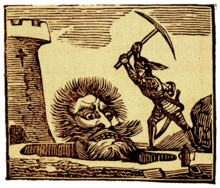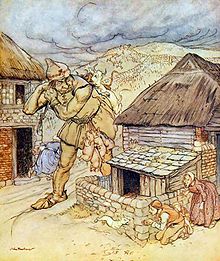- Cormoran
-
Cormoran (pronounced /ˈkɔrməræn/ or /ˈkɔrmərən/), also recorded as Cormilan, Cormelian, Gormillan, or Gourmaillon, was a legendary Cornish giant said to live in a cave on St Michael's Mount and terrorize the people of Penwith (or, in some accounts, all of Cornwall).[2] He is best known as the first giant killed by Jack in the fairy tale "Jack the Giant Killer". In some accounts he is mistakenly identified as Blunderbore.
Contents
Characterization
According to Joseph Jacobs' account, Cormoran was 5.5 m (18 ft) tall and measured about 2.75 m (9 ft) around the waist.[2][3] The giant regularly raided the mainland, "feast[ing] on poor souls…gentleman, lady, or child, or what on his hand he could lay,"[3] and "making nothing of carrying half-a-dozen oxen on his back at a time; and as for…sheep and hogs, he would tie them around his waist like a bunch of tallow-dips."[2]
The giant lived in a cave on St Michael's Mount (a tidal island), utilizing the times of ebb tide to walk to the mainland.[2]
Local legend
According to local legend, Cormoran and his wife Cormelian (whose name also appears as a variant of Cormoran) were responsible for the construction of St Michael's Mount.[4][5] Together they carried granite from the West Penwith Moors to the current location of St Michael's Mount. When Cormoran fell asleep from exhaustion, his wife tried to sneak a greenschist slab from a shorter distance away. Cormoran awoke and kicked the stone out of her apron, where it fell to form the island of Chapel Rock.[5]
Trecobben, the giant of Trencrom Hill (near St Ives), is said to have accidentally killed Cormelian while throwing a hammer over to St Michael's Mount for Cormoran. He and Cormoran buried Cormelian beneath Chapel Rock.[4][5]
Jack the Giant Killer
Further information: Jack the Giant KillerAccording to Joseph Jacobs' account, the councillors of Penzance convened during the winter to solve the issue of Cormoran's raids on the mainland. After offering the giant's treasure as reward for his disposal, a villein farmer's boy named Jack took it upon himself to kill Cormoran.[2] Older chapbooks make no reference to the council, and attribute Jack's actions to a love for fantasy, chivalry, and adventure.[6]
Either way, in the late evening Jack is said to have swum to the island and dug a 6.75 m (22 ft) trapping pit,[2][6] although some local legends suggest he dug the pit to the north in Morvah.[4] After completing the pit the following morning, Jack blew a horn to awaken the giant. Cormoran stormed out, threatening to broil Jack whole, but fell into the hidden pit, and after being taunted for some time, was killed by a blow from a pickaxe or mattock.[3]
After filling in the hole, Jack retrieved the giant's treasure. According to the Morvah tradition, a rock was placed over the grave. Today this rock is called Giant's Grave. Local lore holds that the giant's ghost can sometimes be heard beneath it.
For his service to Penwith, Jack was officially titled "Jack the Giant-Killer"[2] and awarded a belt on which was written:
Here's the right valiant Cornishman,
Who slew the giant Cormoran.Origin
For the geology of the Mount, see St Michael's Mount#Geology.The story of Cormoran may have its roots in the Cornish tale of Corineus (Jack) and Gogmagog (Cormoran).[5] In some renditions of the story, Gogmagog is even referred to as Gourmaillon, a variant of Cormoran. However, this may have been a later hypercorrection.[7]
The death of Cormelian (by a stray hammer) and the death of Cormoran (by a mattock) are similar in form and may share the same origin, and the names "Cormoran" and "Cormelian" seem to share the same etymology, indicating that the legend originally included no wife.
References
- ^ "Chapbooks". L390 Children's Literature. http://www.iupui.edu/~engwft/chapbooks.htm. Retrieved 2009-02-11.
- ^ a b c d e f g Jacobs, Joseph (1890). "Jack the Giant-Killer". English Fairy Tales. London: David Nutt. http://books.google.com/books?id=IZvGIR27HLcC&printsec=titlepage.
- ^ a b c "Jack the Giant Killer, a Hero celebrated by ancient Historians". Banbury. c. 1820. http://www.cts.dmu.ac.uk/AnaServer?hockliffe+2707+imageset.anv. Retrieved 2009-02-11.
- ^ a b c "St. Michael's Mount and the giant Cormoran". http://freepages.folklore.rootsweb.ancestry.com/~hdecent/cornwall/cormoran.htm. Retrieved 2009-02-11.
- ^ a b c d Rose, Carol (2001). Giants, Monsters, and Dragons. W. W. Norton & Co. p. 87. ISBN 0393322114. http://books.google.com/books?id=GKrACS_n86wC&printsec=frontcover.
- ^ a b "Jack the Giant-Killer: Page 1". http://www.iupui.edu/~engwft/slide46l.JPG. Retrieved 2009-02-11.
- ^ "Gogmagog". http://www.highbeam.com/doc/1O73-Gogmagog.html. Retrieved 2009-02-11.
Categories:- Arthurian characters
- British folklore
- Jack the Giant Killer
- Cornish folklore
- English giants
Wikimedia Foundation. 2010.


